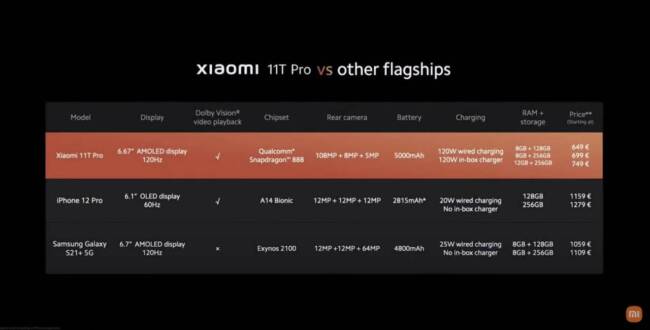If a large display with a fast refresh rate, a speedy processor, and a solid camera for content creation on the go is essential to you, then you’ll want to take a look at the two new Xiaomi 11T series devices launched today. Both the 11T and the 11T Pro offer what Xiaomi calls “Cinemagic” cameras; they say you can leave the expensive video and photography equipment at home (or better yet, not buy it in the first place), go out and explore and get your best shots. Best of all, both phones are affordable.

Founded to make quality technology accessible to everyone, after 11 years, Xiaomi is now the number two smartphone brand worldwide, the number one smartphone brand in Europe, and the number one brand in 22 other global smartphone markets. So while many of us in the US may not be as familiar with them as we are with other brands (yet, anyway), they have been listed on the Fortune Global 500 list for three consecutive years, rising 84 places in 2021 to number 338.
The Xiaomi T series places a heavy focus on flagship cameras and leading technology. At the core of the Xiaomi 11T series is what they call “Cinemagic,” which they describe as the “feeling of you being pulled into a great story, feeling the same emotions as the characters in the film. That feeling of being on the edge of your seat, wanting to find out what happens next.”
The apparent segue is that the Xiaomi 11T series gives you the power to create that type of Cinemagic feeling in your videos without the need to invest in expensive equipment, bulky cameras, complicated technical know-how, or fancy editing. And the ability to experience the result without a large screen or costly sound system.
Taking inspiration from iconic vintage film recorders that brought us iconic movies, the engineers at Xiaomi reflected the two reels of classic film recorders in the Xioami 11T’s camera design. A red accent dot, reminiscent of those video recorder reels, is on the bottom left of the camera array, reminiscent of the blinking light on a video camera. Although this dot doesn’t glow red when you’re shooting a video, it’s a cute and nostalgic touch.
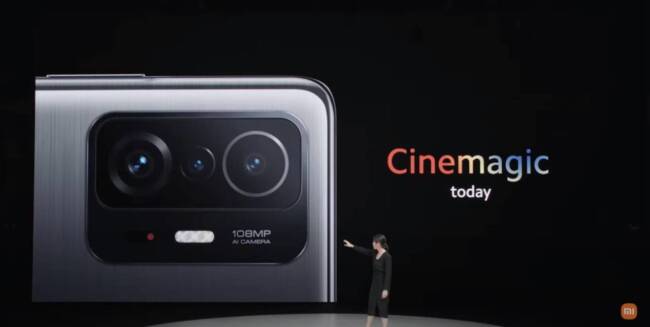
Since the phones share a lot of features, I’ll cover those first, then I’ll tell you about what might push you toward one device over the other, assuming they are available in your region.
The phones appear to look just alike, but there are some subtle differences. Whey they each measure 6.46″ tall by 3.02″ wide by 0.35″ thick, the Xiaomi 11T Pro weighs 7.19 ounces, and the Xiaomi 11T weighs slightly less at 7.16 ounces. They are designed with tapered edges and a 3D quad-curved back for comfort when held in your hand.
The Xiaomi 11T is slimmer and sleeker than the previous 10T generation; both the Xiaomi 11T and the Xiaomi 11T Pro are available in Meteorite Gray (with a brushed metal finish), Moonlight White, Celestial Blue (a dynamic, iridescent finish).
The Xiaomi 11T series smartphones come with a brilliant 6.67″ flat AMOLED (2400×1080 with a 20:9 aspect ratio) HDR10+ TrueColor display with up to 1000nits of peak brightness, 120Hz AdaptiveSync refresh rates for smoother scrolling, and 480Hz touch sampling rates for less lag between your finger touching the display and the action you want to happen to occur. Both versions of the Xiaomi 11T use Corning Gorilla Glass Victus for their displays.
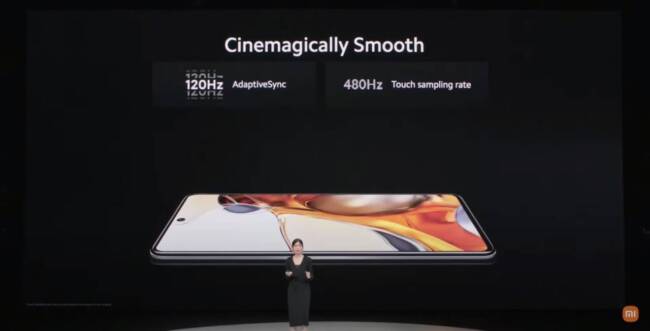
On the front of the Xiaomi 11T and the 11T Pro, there is a 20-megapixel front-facing center hole-punch camera.
On the back, both the 11T and the 11T Pro include a 108-megapixel wide-angle camera, an 8-megapixel 120º ultra-wide-angle camera, and a 5-megapixel 2X telemacro camera which allows you to capture close-up shots from a bit further away (helpful when you want to keep your subject well-lit). Xiaomi describes the three cameras as “pro-grade AI-powered comeras, so you’ll never miss a moment.”

They are also powered with plenty of cinematic effects so that you can capture your own “Cinemagic moments.” Where before you might have needed a green screen, multiple takes, and complicated editing software, Xiaomi engineers have what they call One-Click Cinemagic.
By compressing complicated algorithms into a simple and easy-to-use interface, when shooting video, you’ll have access to tools like Magic Zoom (also called Hitchcock Zoom), which is a special effect that Hollywood often uses to create cinematic suspense. The Magic Zoom AI creates hundreds of key points to create real-time subject and portrait tracking. The result is an illusion that the world is closing in on your subject by magnifying their tracked portrait.
The Xiaomi 11T series also has Macroscope video, with which you can shoot videos of tiny details on everyday items from an unexpected perspective. Audio Zoom lets you zoom into the sound of your subject as you are recording. Hence, as you zoom into an object — like logs cracking on the fireplace, for instance — the sounds of the item you are recording will get louder as the recorded image becomes more prominent.
If you zoom out away from your subject, the sounds will recede. To enable Audio Zoom in the video, the T series has a third microphone that triangulates the sound of your subject, minimizing other unwanted surrounding sounds.
Those are just a few of the Xiaomi 11T series cinematic tools, and if you are a creator, you’ll have fun exploring them. One of the first main differences between the two models that I’ll point out is that the Xiaomi 11T can record video in up to 4K resolution, where the Xiaomi 11T Pro can record video in up to 8Kresolution with HDR10+.
Neither phone has facial recognition for unlocking, which I have to admit in this time of mask-wearing doesn’t seem to be any significant loss. These smartphones do have a fingerprint scanner sleekly built into their power buttons, or you can use a PIN, password, or pattern to access the device.
Both Xiaomi 11T models have dedicated dual Dolby Atmos speakers at the top and bottom of the smartphone for bigger and crisper sound. The Xiaomi 11T Pro takes it a step further with Dolby Vision and extra turning by Harman Kardon for a genuinely cinematic cinemagic experience.

Both phones have Bluetooth 5.2, Wi-Fi 6, DualSIM, and multi-functional NFC; depending upon availability and local operator support, you may also get 5G. They run Android 11 with the Xiaomi MIUI 12.5 overlay, and Xiaomi promises three years of Android OS updates and four years of security patches.
Now let’s talk about a few other differences between the Xiaomi 11T series devices.
The Xiaomi 11T
The Xiaomi 11T uses the flagship MediaTek Dimensity 1200 chipset as its processor, which supports phone cameras of up to 200-megapixels with five-core HDR-ISP and staggered 4K HDR video capture. This chip also has an updated integrated Hexa-core AI processor with an advanced multi-task scheduler to reduce latency and improve power efficiency.
Inside, there are two 2,500mAh batteries for a combined 5,000mAh total. Xiaomi says that with the included in the box 67W wired charger, your battery can go from 0 to 100% in about 36 minutes. That’s not too shabby, but note that there is no wireless charging. I happen to have a Xiaomi 11T in for review, so I’ll be looking at battery life and performance in the upcoming weeks.
There are two memory variants of the Xiaomi 11T that will be available, the first has 8GB RAM with 128GB user memory, which will sell for €499; there will also be a version with 8GB RAM and 256GB user memory that will sell for €549. Since there’s no memory card slot, I’d recommend paying the extra €50 and getting the version with more user memory.
The Xiaomi 11T Pro
Without having both Xiaomi 11T series phones in hand, the only real difference I can see on their exteriors is that “Sound by harman/kardon” is stamped on the top of the Xiaomi 11T Pro.
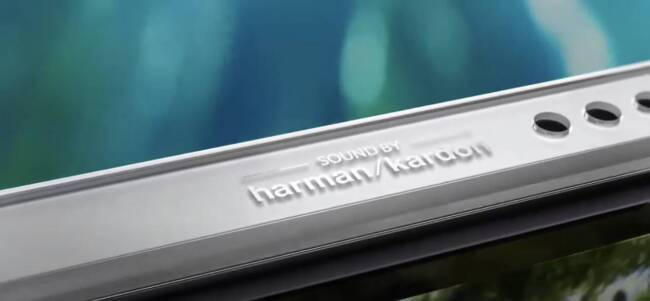
Inside, the Xiaomi 11T uses the flagship Qualcomm Snapdragon 888 chipset as its processor. That platform is further enhanced by the 2nd generation Qualcomm Sensing Hub, which incorporates lower-power always-on AI processing for intuitive, intelligent features.
Powering the Xiaomi 11T Pro are two 2,500mAh batteries with graphene for a combined 5,000mAh total. Here’s where things get interesting, though. The 11T Pro includes a ridiculously fast 120W Xiaomi HyperCharge wall charger in the box, which Xiaomi says will charge your phone from 0-100% in 17 minutes! WHAT?! That means that in the time it takes to grab a snack and then brush your teeth, you can also completely charge your phone’s battery!
But again, there is no wireless charging, and that may be a deal-breaker for some.
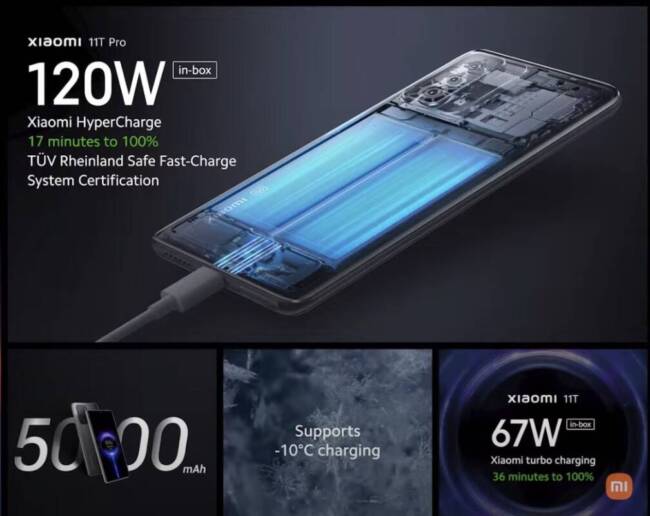
You can purchase the Xiaomi 11T Pro with 8GB RAM and 128GB user memory for €649, 8GB RAM with 256GB user memory for €699, and 12GB RAM with 256GB user memory for €749 — which is well under other flagship phones with somewhat comparable features!
